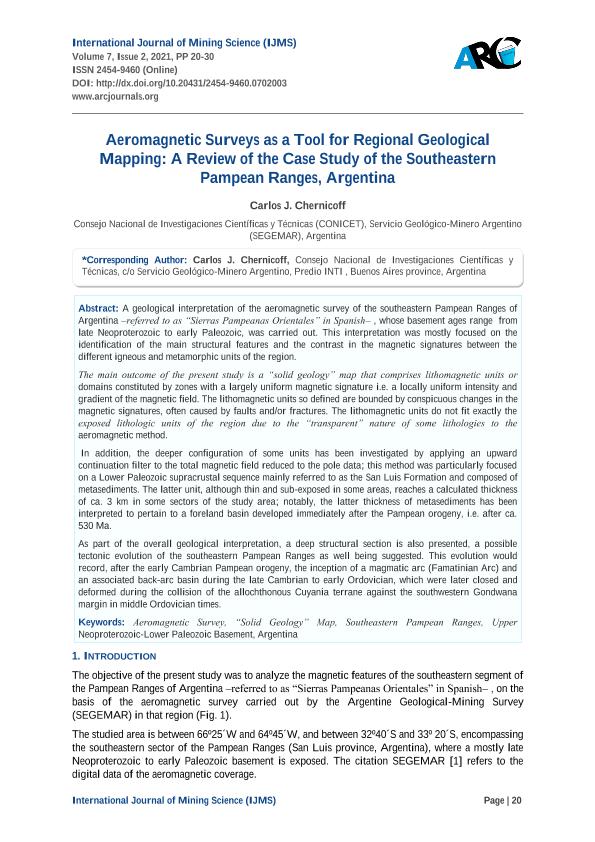Mostrar el registro sencillo del ítem
dc.contributor.author
Chernicoff, Carlos Jorge

dc.date.available
2022-05-13T14:50:34Z
dc.date.issued
2021-03
dc.identifier.citation
Chernicoff, Carlos Jorge; Aeromagnetic Surveys as a Tool for Regional Geological Mapping: A Review of the Case Study of the Southeastern Pampean Ranges, Argentina; ARC Publications; International Journal of Mining Science; 7; 2; 3-2021; 20-30
dc.identifier.issn
2454-9460
dc.identifier.uri
http://hdl.handle.net/11336/157474
dc.description.abstract
A geological interpretation of the aeromagnetic survey of the southeastern Pampean Ranges of Argentina –referred to as “Sierras Pampeanas Orientales” in Spanish– , whose basement ages range from late Neoproterozoic to early Paleozoic, was carried out. This interpretation was mostly focused on the identification of the main structural features and the contrast in the magnetic signatures between the different igneous and metamorphic units of the region. The main outcome of the present study is a “solid geology” map that comprises lithomagnetic units or domains constituted by zones with a largely uniform magnetic signature i.e. a locally uniform intensity and gradient of the magnetic field. The lithomagnetic units so defined are bounded by conspicuous changes in the magnetic signatures, often caused by faults and/or fractures. The lithomagnetic units do not fit exactly the exposed lithologic units of the region due to the “transparent” nature of some lithologies to the aeromagnetic method. In addition, the deeper configuration of some units has been investigated by applying an upward continuation filter to the total magnetic field reduced to the pole data; this method was particularly focused on a Lower Paleozoic supracrustal sequence mainly referred to as the San Luis Formation and composed of metasediments. The latter unit, although thin and sub-exposed in some areas, reaches a calculated thickness of ca. 3 km in some sectors of the study area; notably, the latter thickness of metasediments has been interpreted to pertain to a foreland basin developed immediately after the Pampean orogeny, i.e. after ca. 530 Ma. As part of the overall geological interpretation, a deep structural section is also presented, a possible tectonic evolution of the southeastern Pampean Ranges as well being suggested. This evolution would record, after the early Cambrian Pampean orogeny, the inception of a magmatic arc (Famatinian Arc) and an associated back-arc basin during the late Cambrian to early Ordovician, which were later closed and deformed during the collision of the allochthonous Cuyania terrane against the southwestern Gondwana margin in middle Ordovician times.
dc.format
application/pdf
dc.language.iso
eng
dc.publisher
ARC Publications
dc.rights
info:eu-repo/semantics/openAccess
dc.rights.uri
https://creativecommons.org/licenses/by-nc-sa/2.5/ar/
dc.subject
AEROMAGNETIC SURVEYS
dc.subject
GEOLOGICAL MAPPING
dc.subject
SOUTHEASTERN PAMPEAN RANGES
dc.subject
ARGENTINA
dc.subject.classification
Geología

dc.subject.classification
Ciencias de la Tierra y relacionadas con el Medio Ambiente

dc.subject.classification
CIENCIAS NATURALES Y EXACTAS

dc.title
Aeromagnetic Surveys as a Tool for Regional Geological Mapping: A Review of the Case Study of the Southeastern Pampean Ranges, Argentina
dc.type
info:eu-repo/semantics/article
dc.type
info:ar-repo/semantics/artículo
dc.type
info:eu-repo/semantics/publishedVersion
dc.date.updated
2022-05-09T19:58:04Z
dc.journal.volume
7
dc.journal.number
2
dc.journal.pagination
20-30
dc.journal.pais
India

dc.journal.ciudad
Ongole
dc.description.fil
Fil: Chernicoff, Carlos Jorge. Consejo Nacional de Investigaciones Científicas y Técnicas; Argentina. Secretaría de Industria y Minería. Servicio Geológico Minero Argentino; Argentina
dc.journal.title
International Journal of Mining Science
dc.relation.alternativeid
info:eu-repo/semantics/altIdentifier/doi/http://dx.doi.org/10.20431/2454-9460.0702003
dc.relation.alternativeid
info:eu-repo/semantics/altIdentifier/url/https://www.arcjournals.org/international-journal-of-mining-science/volume-7-issue-2/
Archivos asociados
